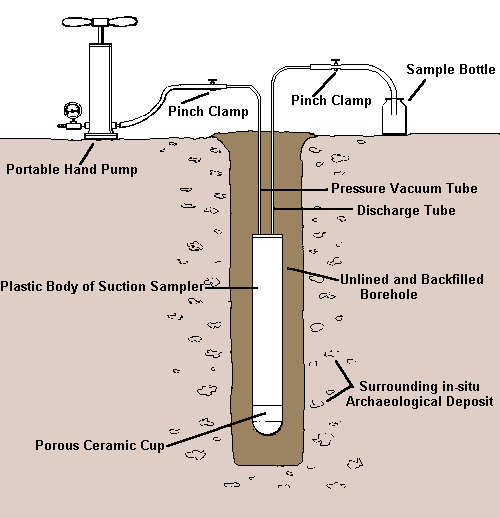
When ground water is not present from which to collect samples for water quality monitoring, 'pressure-vacuum soil water samplers' (suction sampler) can be used. The suction sampler consists of a plastic body that has at the lower end a round bottom porous ceramic cup. At the other end there is a silicone plug through which two polyethylene plastic tubes are inserted; the plug is sealed into the suction sampler body using a threaded clamp ring.
Figure 15: The installation of a suction sampler

The suction samplers are installed down an unlined borehole to the depth from which water samples are to be collected. The boreholes are constructed in the same manner as those used for the installation of the dipwell. Before installation of the suction samplers, a slurry is made from some of the excavated spoil. This is poured to the base of the borehole to ensure a good contact with the porous cup of the suction sampler as it is lowered into the archaeological deposit. The remaining void of the borehole is backfilled with excavated spoil, screened to remove large objects and replaced in the same order in which it was removed. The two tubes that pass into the suction sampler body are the 'pressure-vacuum' tube and the 'discharge' tube. The first tube is inserted through the plug so that it extends into the sampler body by approximately 30mm. The discharge tube is passed through the plug until it almost reaches the base of the sampler. The exposed lengths of tube that pass up the borehole are protected from damage by running them through a thick-walled flexible plastic pipe (19mm internal diameter, 25mm external diameter).
On leaving the borehole, the tubes from each suction sampler are lain along a trench to a single collection point at ground level. To prevent damage to the pipes when the trench is backfilled, the pipes are again laid in protective ducting. Finally, to prevent debris entering the tubes, the ends are sealed with a stainless steel pinch clamp. The suction samplers are now left in place for the duration of the monitoring programme. The installation of a suction sampler is shown in simplified form on Figure 15.
A water sample is collected by first closing the pinch clamp on the discharge tube, then connecting the pressure-vacuum tube to the vacuum port on a portable hand pump. The pump is stroked until a vacuum of approximately 60 centibars is created within the sampler body. The pinch clamp on the pressure-vacuum tube is then closed securely to seal the sampler under vacuum. The hand pump can then be removed for other uses.
The suction sampler is allowed to sit for a period of time under vacuum which causes water to move from the deposit, through the porous cup and into the sampler. To recover a water sample, the pressure-vacuum tube is connected to the hand pump's pressure port and the discharge tube is placed in a sample bottle. The pinch clamps on both tubes are opened and a few strokes of the hand pump are then used to develop enough pressure within the suction sampler to force water into the sample bottle. The water first obtained is discarded since it may contain residues from the previous sampling operation. Sampling continues until all water within the suction sampler has been collected.
© Author(s). Content published prior to 2013 is not covered by CC-BY licence and requests for reproduction should usually go to the copyright holder (in most cases, the author(s)). For citation / fair-dealing purposes, please attribute the author(s), the title of the work, the Internet Archaeology journal and the relevant URL/DOI.
Last updated: Thur Feb 28 2002